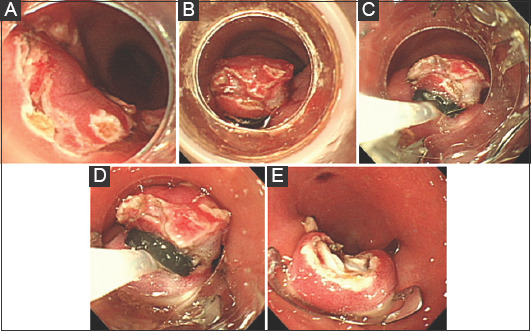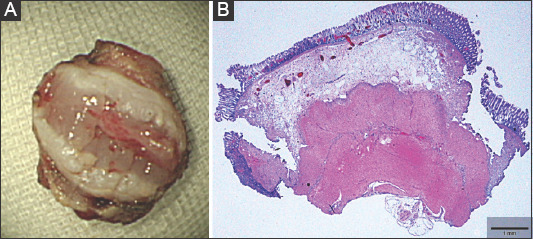Because most neuroendocrine tumors (NETs) invade the deep submucosal layer [1], small NETs are a kind of tumors indicated for endoscopic full-thickness resection (EFTR) using an over-the-scope clip (OTSC; Ovesco Endoscopy, Tübingen, Germany) [2]. EFTR is a potentially curative procedure compared with conventional methods that resect only the submucosal layer. However, a new FTR device (Ovesco Endoscopy) [3] is unavailable worldwide. We herein describe a novel ligation-assisted EFTR using the original OTSC (l-FTRO) to target small NETs in an animal experiment using a beagle dog (Video 1).
First, a circumferential incision was made around the marking dots in the lower rectum until the muscle layer appeared (First step, Incision: Fig. 1A). Next, after firing the O-ring (endoscopic variceal ligation device, EVL; MD-48720U, Sumius, Tokyo, Japan) directly beneath the prepared incision line (Second step, EVL: Fig. 1B), we constricted a thin snare (Snare Master, SD-221L-25; Olympus) below the ring (Third step, Snaring: Fig. 1C). While aspirating the snare into the cap, the OTSC was deployed (Fourth step, OTSC: Fig. 1D). Finally, EFTR with the snare was achieved using an electric generator (VIO300D; Endo Cut Q mode, ERBE, Germany) (Fifth step, EFTR: Fig. 1E). The total procedure time was 16 min, and histological examination of an en bloc specimen (Fig. 2A) confirmed an adequate full-thickness layer (Fig. 2B). The advantages are follows: The incision enables the muscle layer to be identified, the O-ring prevents the snare from slipping, and preparing the snare before OTSC deployment ensures complete EFTR. Therefore, l-FTRO may be reliable for treating small NETs.
Figure 1.

(A) Endoscopic view showing the circumferential incision around the marking dots in the lower rectum (First step, Incision). (B) Endoscopic view showing the O-ring fired directly beneath the prepared incision line (Second step, EVL). (C) Endoscopic view showing the thin snare constricted below the ring (Third step, Snaring). (D) Endoscopic view showing OTSC deployment while aspirating the snare into the cap (Fourth step, OTSC). (E) Endoscopic view showing the completed EFTR with the snare (Fifth step, EFTR)
EVL, endoscopic variceal ligation; OTSC, over-the-scope clip; EFTR, endoscopic full-thickness resection
Figure 2.

(A) Macroscopic image showing the full-thickness resected specimen. (B) Histological finding revealing the full-thickness layer
Video 1
EFTR is a therapeutic option indicated for small NETs infiltrating the submucosa. This video shows that ligation-assisted EFTR with the original OTSC (l-FTRO) enables reliable full-thickness resection without the snare slipping
EFTR, endoscopic full-thickness resection; NET, neuroendocrine tumor; OTSC, over-the-scope clip
Biography
Kagawa University, Kagawa, Japan
Footnotes
Conflict of Interest: None
References
- 1.Zhou X, Xie H, Xie L, Li J, Cao W, Fu W. Endoscopic resection therapies for rectal euroendocrine tumors:a systematic review and meta-analysis. J Gastroenterol Hepatol. 2014;29:259–268. doi: 10.1111/jgh.12395. [DOI] [PubMed] [Google Scholar]
- 2.Kobara H, Mori H, Nishiyama N, et al. Over-the-scope clip system:A review of 1517 cases over 9 years. J Gastroenterol Hepatol. 2018;34:22–30. doi: 10.1111/jgh.14402. [DOI] [PubMed] [Google Scholar]
- 3.Schmidt A, Beyna T, Schumacher B, et al. Colonoscopic full-thickness resection using an over-the-scope device:a prospective multicentre study in various indications. Gut. 2018;67:1280–1289. doi: 10.1136/gutjnl-2016-313677. [DOI] [PubMed] [Google Scholar]
Associated Data
This section collects any data citations, data availability statements, or supplementary materials included in this article.


